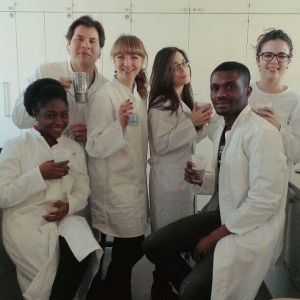All good things come in threes. Besides terrestrial and aquatic ecotoxicology, human toxicology also plays a role in the master’s program Ecotoxicology. The toxicology and pharmacology lab course covers three relevant principles of human toxicology. It provides both theoretical background and hands-on experience – featuring coffee drinkers, liver and mutagenicity detectives.
Drinking coffee is science
Every scientist has to make sacrifices for his research from time to time. The Ecotox students took the challenge. Being the subject of their own experiment aiming to determine their caffeine clearance, they consumed one cup of Nescafe Gold granulate coffee within five minutes – without milk, sugar or breakfast. Afterwards, highly concentrated of course, the students started sampling using small test tubes. Besides one sample of the overly delicious coffee, six saliva samples were taken after specific time intervals. Finally, the samples were diluted for the HPLC-MS analysis. With the results of the sample analysis, both the caffeine clearance and the half-life were determined. For coffee drinkers it’s an interesting fun fact to know how long your beloved morning drink affects you. Did you know that the metabolic rate for caffeine can be influenced by many factors such as age, pregnancy or smoking?
What happened to this liver?
Feeling like real toxicological detectives, the Ecotox students investigated the pathology of a control and a treated liver sample with a microscope. Finding the adequate magnification was tricky but in the end, the difference between the two samples was obvious. The treatment sample showed larger cells around the central vein in the first few cell layers. Conclusions were drawn about which phenomenon caused this abnormality, including possible diagnoses – but they will be kept secret at this point as new detectives will search for traces next year as well.
Ames reveals mutagenicity
Is eucalyptus oil or laundry detergent mutagenic? In order to answer this question, the Ecotox students conducted an Ames test, a biological assay which assesses the mutagenicity of a compound. The test uses strains of the bacterium Salmonella typhimurium carrying specific mutations in genes involved in the synthesis of the amino acid histidine. The used strains are auxotrophic which means they need histidine for growing but are not able to produce it. The Ames test investigates if the test substance creates mutations resulting in a return to prototrophy enabling growth on a histidine-free medium. After several preparation steps, the students mixed their potentially mutagenic compound with liquid topagar and plated it onto the agar medium, followed by incubation. For the assessment of mutagenicity, the revertant colonies were counted and compared to the number of spontaneous revertant colonies on the solvent control plates. Luckily, neither eucalyptus oil nor laundry detergent turned out to be mutagenic.



